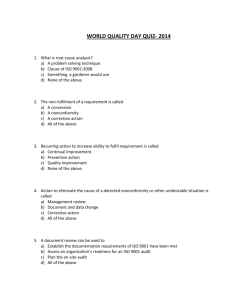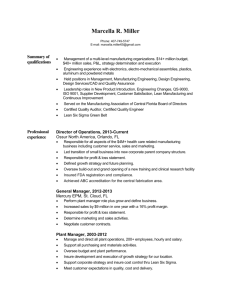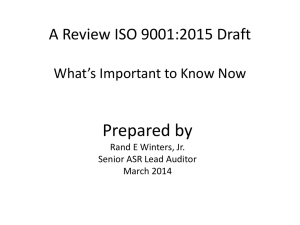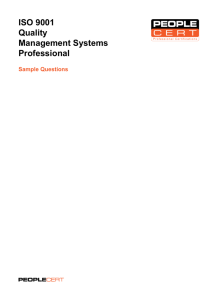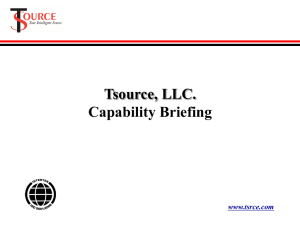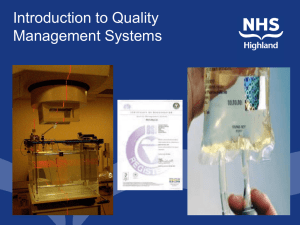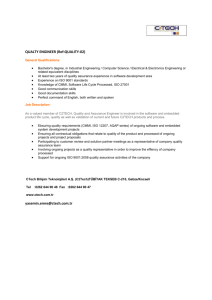is bs7750 a better standard than iso 9001?
advertisement
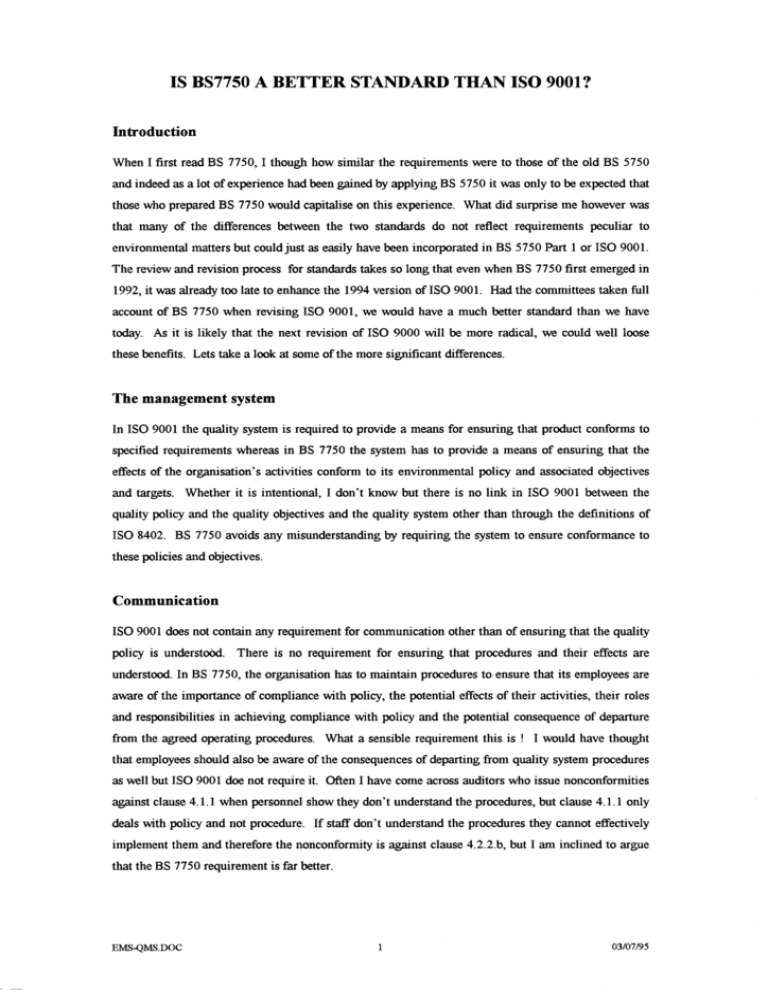
IS BS7750 A BETTER STANDARD THAN ISO 9001? Introduction When I first read BS 7750, I though how similar the requirements were to those of the old BS 5750 and indeed as a lot of experience had been gained by applying BS 5750 it was only to be expected that those who prepared BS 7750 would capitalise on this experience. What did surprise me however was that many of the differences between the two standards do not reflect requirements peculiar to environmental matters but could just as easily have been incorporated in BS 5750 Part 1 or ISO 9001. The review and revision process for standards takes so long that even when BS 7750 first emerged in 1992, it was already too late to enhance the 1994 version of ISO 9001. Had the committees taken full account of BS 7750 when revising ISO 9001, we would have a much better standard than we have today. As it is likely that the next revision of ISO 9000 will be more radical, we could well loose these benefits. Lets take a look at some of the more significant differences. The management system In ISO 9001 the quality system is required to provide a means for ensuring that product conforms to specified requirements whereas in BS 7750 the system has to provide a means of ensuring that the effects of the organisation's activities conform to its environmental policy and associated objectives and targets. Whether it is intentional, I don't know but there is no link in ISO 9001 between the quality policy and the quality objectives and the quality system other than through the definitions of ISO 8402. BS 7750 avoids any misunderstanding by requiring the system to ensure conformance to these policies and objectives. Communication ISO 9001 does not contain any requirement for communication other than of ensuring that the quality policy is understood. There is no requirement for ensuring that procedures and their effects are understood. In BS 7750, the organisation has to maintain procedures to ensure that its employees are aware of the importance of compliance with policy, the potential effects of their activities, their roles and responsibilities in achieving compliance with policy and the potential consequence of departure from the agreed operating procedures. What a sensible requirement this is ! I would have thought that employees should also be aware of the consequences of departing from quality system procedures as well but ISO 9001 doe not require it. Often I have come across auditors who issue nonconformities against clause 4.1.1 when personnel show they don't understand the procedures, but clause 4.1.1 only deals with policy and not procedure. If staff don't understand the procedures they cannot effectively implement them and therefore the nonconformity is against clause 4.2.2.b, but I am inclined to argue that the BS 7750 requirement is far better. EMS-QMS.DOC 1 03/07/95 Training A slight change in the wording of the training requirement between ISO 9001 and BS 7750 creates an additional much needed requirement for procedures. ISO 9001 requires organisations 'to maintain procedures for identifying training needs and provide for the training of all personnel.... It does not require a procedure for providing training. BS 7750 on the other hand requires organisations 'to maintain procedures for identifying training needs and for providing appropriate training for all personnel....' This is a far better requirement and removes any ambiguity in ISO 9001 clause 4.18. Register of requirements BS 7750 requires a record of all legislative, regulatory and other policy requirements pertaining to the environmental aspects of its activities etc. Whilst ISO 9001 does require design input to include applicable statutory and regulatory requirements there is no requirement to capture and record customer needs and expectations, legislative and regulatory and other requirements relating to the products, services and processes supplied. If these requirements are not defined in the contract and there is no design activity, the identity of these requirements is left to chance. Quality policy has to be relevant to customer needs and expectations but these are not required to be documented and the register maintained. In clause 4.9 controlled conditions have to ensure compliance with reference standards, but referenced where and by whom? Suppliers are not compelled to maintain a register of such standards so again the BS 7750 requirement is more precise and less ambiguous Effects BS 7750 requires an examination and assessment of environmental effects covering amongst other things, controlled and uncontrolled emissions, contamination, incidents and accidents etc. Whilst undue attention to the effects of activities on the environment has consequences beyond the organization, this is true also of quality. ISO 9001 does not require organizations to examine the effects of potential failure in the function of the product or service they provide. QS 9000 issued by the American Automobile industries does require Failure Modes and Effects Analysis to be performed and as human safety is involved it is understandable why. Safety is involved in products much more mundane than automobiles, in fact every product has some safety hazard that needs elimination, containment or control so ISO 9001 would be improved significantly by the addition of a similar clause to that in BS 7750. Objectives and targets BS 7750 requires procedures for specifying objectives and consequent targets at all levels and these to be linked to the assessment of the environmental effects. Also these objectives have to be quantified and their achievement measured. ISO 9001 is particularly weak on objectives there being only a minor reference to quality objectives in the quality policy. They do not have to be quantified or linked to any failure modes analysis or their achievement measured. EMS-QMS.DOC 2 03/07/95 Policy ISO 9001 requires suppliers to define and document its quality policy and BS 7750 does likewise with respect to the environment. However where the two standards differ is in how they convey the content of such policy. ISO 9001 gives no clue as to what should be contained in a quality policy except that it shall include quality objectives. BS 7750 does not require objectives to be included, but requires the policy to provide for the setting of objectives. A far more practical way of stating the requirement as the practice of including objectives in a policy statement discourages their quantification. But apart from the objectives the environmental policy has to include a commitment to continual improvement, state which of the activities are covered by the system and indicate how the objectives will be made publicly available. Certainly a commitment to continual quality improvement is something that should have been required in ISO 9001. Management programme The quality plan could be analogous to the environmental management programme in BS 7750. However, quality plans are contract/project/product specific. Some companies do use them to plan the achievement of their corporate objectives but many don't and would not be noncompliant with ISO 9001 if they failed to do so. There is no requirement for any plans to be prepared to achieve stated quality objectives either for control or improvement. Had ISO 9001 distinguished between contract/project/product specific requirements and those pertaining to the organization as a whole, then this confusion may be overcome. The addition of a quality management programme or annual quality programme would be a distinct benefit to ISO 9001. The Manual ISO 9001 1994 now requires a quality manual to be prepared but is brief on what such a manual shall contain. BS 7750 requires the manual to collate the policy , objectives, targets, programmes, documentation and responsibilities. It also requires the manual to describe the interactions of system elements, a much 'needed requirement in ISO 9001 to stop the unhelpful practice of limiting the content to Records Whilst ISO 9001 is strong on records there are ambiguities in the text which make it ineffective. ISO 9001 requires records to be maintained to demonstrate conformance to specified requirements and the effective operation of the quality system. It does not define what specified requirements are in this context or what is required to demonstrate effective operation of the quality system. BS 7750 on the other hand is more precise. Records are required in order to demonstrate compliance with the requirements of the environmental management system and to record the extent to which planned environmental objectives and targets have been met. ISO 9001 does not require the same with respect to quality. Whilst in ISO 901 terms such a requirement would be very onerous, at least suppliers EMS-QMS.DOC 3 03/07/95 would know what they had to record. At present they either record everything hoping to have covered more than needed or fall hopelessly short of the minimum requirement. Audits ISO 9001 requirements for audits cover audit planning but do not specify the range of areas which audits shall address other than the vague expression, `....whether quality activities comply with planned arrangements' BS 7750 goes much further and requires the audit of organization structures and processes in addition to the usual procedural activities. BS 7750 also goes further on what shall be included in audit reports, covering conformity and nonconformity, conclusions and recommendations and more pertinent the effectiveness of the system in meeting the objectives and targets. These aspects are addressed in ISO 10011 but this is only a guide and so cannot be used in 3rd party Certification Audits to issue nonconformities. Conclusions I have only addressed some of the more significant differences between ISO 9001 and BS 7750. There are also many changes made to ISO 9001 in 1994 which could well be incorporated into BS 77501 and I haven't sort in this article to point out the weaknesses in BS 7750 however, it would appear that there are far less than in ISO 9001. I haven't yet seen ISO 14001 but I believe it to be vastly different to BS 7750. However, I feel that the writers of BS 7750 deserve some praise as they at least have corrected some of the weaknesses still present in ISO 9001. Let us hope, the authors of ISO 9001-2000 take account of the good work done in the environmental sector committees and incorporate the many beneficial features of BS 7750. References BS 7750 1994 Environmental management systems ISO 9001 1994 Quality systems - Model for quality assurance in design/development, production, installation and servicing David Hoyle Freelance consultant, instructor, auditor and author on quality management 26 June 1995 EMS-QMS.DOC 4 03/07/95


